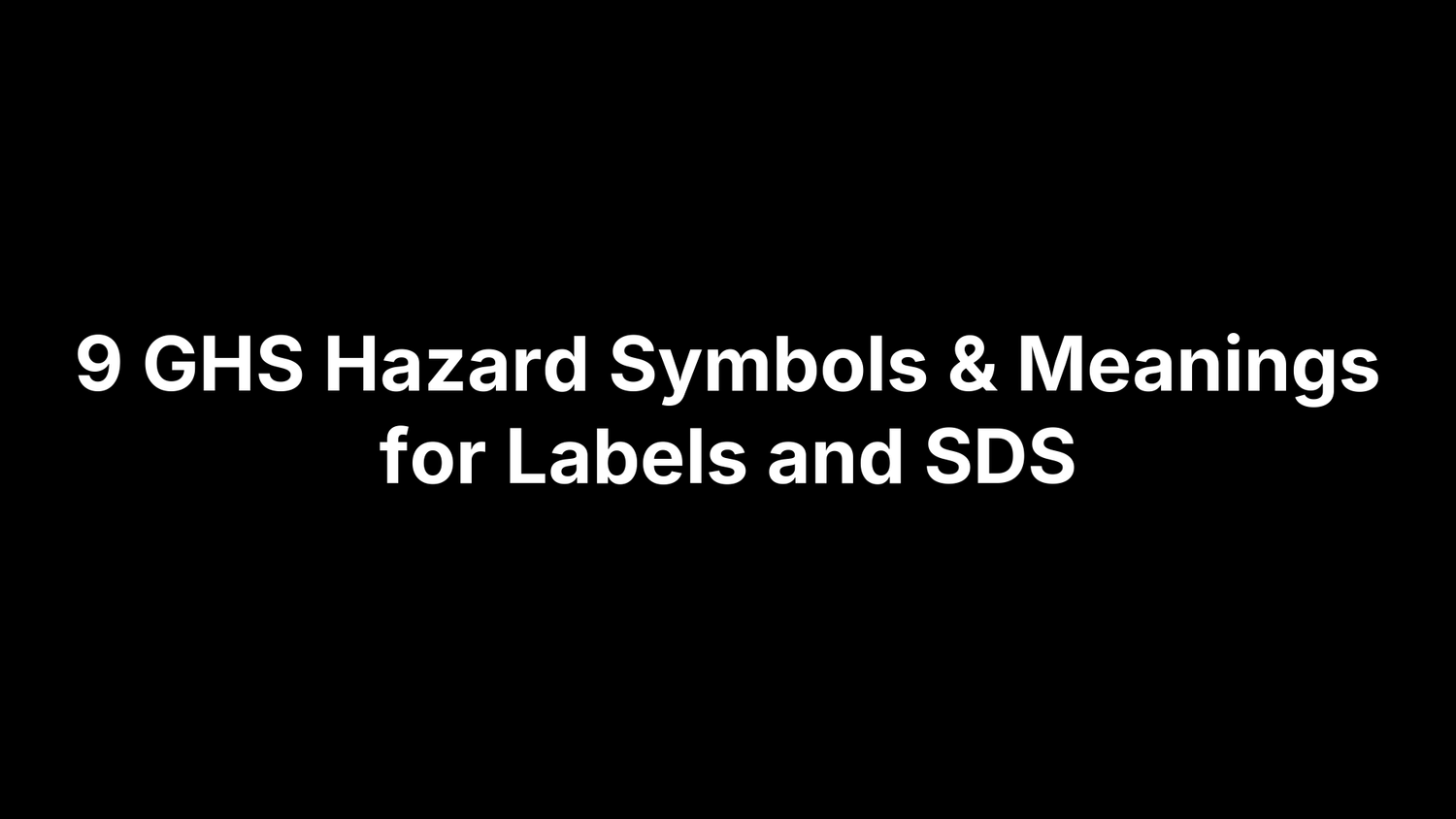9 GHS Hazard Symbols & Meanings for Labels and SDS
Those red diamonds on chemical drums aren’t decoration—they’re the Globally Harmonized System (GHS) talking to you. GHS assigns nine pictograms, each tied to specific hazard classes, for container labels and Section 2 of Safety Data Sheets. OSHA’s Hazard Communication Standard enforces eight in U.S. workplaces; the environment symbol is optional but common internationally. Mastering them is step one toward compliance and injury prevention.
This guide strips away jargon and walks through each icon: how it looks, the hazards it signals, which signal words and statements to print, plus lab-tested handling tips. Whether you manage a single fume hood or a nationwide fleet of tankers, you’ll leave with clear, actionable steps to update labels, train staff, and satisfy auditors. Read on, match the diamond in your hand to the sections below, and keep every shift safer and citation-free.
1. Exploding Bomb — Explosives, Self-Reactives & Organic Peroxides
When you see the exploding-bomb pictogram, think instantaneous energy release. This GHS symbol flags chemicals that can detonate, deflagrate, or violently decompose under heat, shock, or friction—risks that require more than “normal” flammable-liquid precautions.
What the Symbol Looks Like
A red-bordered diamond containing a black object ripped apart by radial fragments. One glance tells trained staff that even a minor jolt could trigger disaster.
Hazards & GHS Classes Covered
- Explosives (Divisions 1.1–1.6)
- Self-reactive substances, Types A & B
- Organic peroxides, Types A & B
These materials generate oxygen or gas faster than it can escape, creating detonation or rapid burning pressure waves.
Required Label Elements
- Signal word: Danger
- Sample hazard statements:
H200 Unstable explosive,H242 Heating may cause a fire or explosion - Precautionary codes: P210 (keep away from heat), P411 (store at ≤ temperature listed on SDS).
Common Examples & Best Practices
Nitroglycerin, picric acid crystals, and benzoyl-peroxide initiators are classic culprits. Store them in approved magazines, segregate from sparks and impact zones, and ground metal tools. Annual competency drills keep crews ready for the rare—but catastrophic—runaway reaction.
2. Flame — Flammables, Pyrophorics, Self-Heating & More
If a chemical can catch fire with little provocation, the flame pictogram is its calling card. Seeing this diamond on a drum, aerosol can, or shipping paper means vapors may ignite below room temperature, solids may spontaneously combust, or the product can fuel a stubborn fire once it starts. Proper storage and labeling keep that risk from turning into an incident report.
Visual Description
A black flame sits on a small horizontal line inside the red-framed diamond—an unmistakable “something can burn here” cue among the nine GHS symbols.
Hazard Classes
- Flammable gases, aerosols, liquids, and solids
- Self-reactive substances Types C–G
- Pyrophoric liquids/solids
- Self-heating substances
- Organic peroxides Types C–G
- Substances that emit flammable gas on contact with water
Label & SDS Requirements
- Signal word: Danger for Categories 1–2; Warning for lower categories
- Core hazard statements like
H225 Highly flammable liquid and vapororH250 Catches fire spontaneously if exposed to air - Cross-reference SDS Section 5 so responders know whether to reach for CO₂, dry chemical, or a Class D extinguisher.
Safe Handling Tips
Keep sources of ignition 25 ft away, ground and bond transfer containers, and store below the lowest flash point listed. Use intrinsically safe tools for solvents such as acetone or fuels like propane, and never rely on a standard refrigerator—choose an explosion-proof unit instead.
3. Flame Over Circle — Oxidizers
When this pictogram shows up, it flags chemicals that don’t burn themselves but feed oxygen (or another oxidizing element) to any nearby fuel. Treat it as a “fire booster” warning: a small spark that would normally fizzle can roar when an oxidizer is in the mix. Correctly identifying the symbol GHS assigns to oxidizers is essential for storage segregation, emergency response, and OSHA inspections.
Icon Breakdown
A red diamond containing a black flame perched over a thin ring—the “circle” that hints at added oxygen.
Covered Hazards
- Oxidizing gases (Category 1)
- Oxidizing liquids (Categories 1–3)
- Oxidizing solids (Categories 1–3)
These materials accelerate combustion or cause it in combustible substances.
Label Elements & Compatibility
- Signal word: Danger for Category 1; Warning for Categories 2–3
- Hazard statement example:
H270 May cause or intensify fire; oxidizer - Store away from flammables, organics, and reducing agents.
Real-World Examples
Compressed oxygen, 70 % hydrogen peroxide, sodium chlorate pellets. Use non-sparking tools, dedicated oxidizer cabinets, and clean spills with inert absorbents.
4. Gas Cylinder — Gases Under Pressure
The gas-cylinder pictogram flags any vessel holding compressed, liquefied, or dissolved gas. A snapped valve can turn it into a rocket or unleash cryogenic fumes, so correct storage and labeling are non-negotiable.
Recognizing the Symbol
Black outline of a cylinder lying on its side inside the red diamond—hard to miss on a shipping label.
Hazard Categories
- Compressed gas
- Liquefied gas
- Refrigerated liquefied gas
- Dissolved gas
Label & SDS Details
- Signal word: none unless combined with another hazard class
- Hazard statement:
H280 Contains gas under pressure; may explode if heated(cryogenics add “may cause cold burns”) - Check SDS Sections 7 & 10 for pressure limits and compatible materials
Handling & Storage
- Chain cylinders upright; leave protective caps on when idle
- Keep below 125 °F and away from ignition or radiant heat
- Move with approved carts; segregate oxidizers, flammables, and toxics
5. Corrosion (Hand & Metal) — Skin Burns, Eye Damage & Metal Corrosion
The corrosion symbol GHS assigns warns that a substance can eat through skin, eyes, and even steel. Spot it on labels or SDS Section 2 and suit up fast.
Symbol Anatomy
Red diamond shows two test tubes dripping onto a hand and a metal bar, both fuming—graphic proof of simultaneous tissue and hardware damage.
Hazards Defined
Used for Skin Corrosion 1A-1C, Eye Damage 1, and Corrosive to Metals—hazards that can cause irreversible burns or metal loss in minutes.
Label Essentials
Signal word Danger. Key statements: H314 Causes severe skin burns and eye damage, H318 Causes serious eye damage, H290 May be corrosive to metals. Pair with P280 (wear protective gloves/eye protection) and P303+361+353 (rinse skin immediately).
Safe Use Examples
Think hydrochloric acid baths, caustic soda CIP solutions, and battery acid. Wear butyl gloves and a face shield, neutralize spills with baking soda, and segregate containers from reactive metals and oxidizers.
6. Skull and Crossbones — Acute Toxicity (Fatal or Toxic)
When this pictogram pops up, you’re dealing with a chemical that can kill quickly through a single exposure. It’s the most immediate life-threat warning in the entire symbol GHS suite, signaling that even a splash, sip, or whiff can be lethal. Treat containers bearing this diamond like a loaded weapon: isolate them, engineer out vapors, and keep the antidote kit within arm’s reach.
Visual Cue
A stark black skull above two crossed bones centered in the red-bordered diamond—impossible to confuse with any other hazard icon.
Hazard Categories
- Acute oral, dermal, or inhalation toxicity Categories 1–3
- Category 1: fatal in microgram doses
- Category 2–3: fatal or toxic at low mg/kg ranges
Label & SDS Requirements
- Signal word: Danger
- Hazard statements:
H300 Fatal if swallowed,H310 Fatal in contact with skin,H330 Fatal if inhaled - Section 4 must outline specific first-aid antidotes and an emergency phone number.
Example Chemicals & Controls
- Sodium cyanide, hydrogen sulfide, methanol, nicotine base
- Controls: closed transfer systems, local exhaust with continuous gas monitoring, supplied-air respirators, and locked storage accessible only to trained personnel.
7. Health Hazard Silhouette — Carcinogens, Respiratory Sensitizers & More
Spot the human torso with a starburst and you’re looking at longer-term, “slow burn” dangers rather than instant explosions or fires. This symbol GHS reserves for chronic or systemic effects—cancer, genetic damage, fertility harm, organ failure, even lethal aspiration of hydrocarbons. Because these outcomes develop over weeks, years, or one unlucky gulp, workers can underestimate the risk unless labels and training spell it out.
Icon Details
Black silhouette of an upper body with a white, six-point burst on the chest, framed by the red diamond.
Hazard Classes Covered
- Carcinogenicity
- Germ-cell mutagenicity
- Reproductive toxicity
- Respiratory sensitization
- Specific target organ toxicity (single or repeated)
- Aspiration hazard
Label & SDS Checklist
- Signal word: Danger for Categories 1A/1B; Warning for lower tiers.
- Core hazard statements:
H350 May cause cancer,H334 May cause allergy or asthma symptoms. - Cross-reference SDS Sections 4, 11, 12 for medical, toxicological, and ecological data.
Practical Examples
Benzene, asbestos fibers, di-isocyanate hardeners, and mineral oils with <25 % DMSO extract. Controls include closed-loop transfers, respiratory protection with quantitative fit-testing, substitution where feasible, and periodic medical surveillance for exposed employees.
8. Exclamation Mark — Irritation, Skin Sensitization & Ozone Layer Hazard
Think of this diamond as the “handle with care” alert. It tells workers the substance won’t necessarily kill or burn, but it can still sting skin, cloud vision, fog brains, or nibble at the ozone layer. Because the dangers vary, reading the fine print beside the pictogram is key to proper PPE and ventilation choices.
Symbol Summary
A bold black exclamation mark centered in a red-bordered diamond—simple, universal, and easy to spot among the broader symbol GHS lineup.
Applicable Hazards
- Acute toxicity, Category 4
- Skin or eye irritation
- Skin sensitization
- Specific target organ toxicity (single exposure) Category 3, including respiratory irritation and narcotic effects
- Ozone layer hazard
Labeling Nuances
Signal word: Warning.
Common hazard statements: H317 May cause an allergic skin reaction, H335 May cause respiratory irritation. If a chemical also meets Health-Hazard criteria, use only the more severe pictogram per GHS precedence rules.
Usage Scenarios
Acetone cleaners, latex paints, and xylene thinners often carry this mark. Controls include local exhaust, splash goggles, nitrile gloves, and, when feasible, swapping in low-VOC or fragrance-free formulas.
9. Environment — Aquatic Toxicity (Optional Under OSHA)
While OSHA doesn’t mandate it, the environment pictogram appears on many globally traded products to flag eco-toxicity concerns.
Visual Description
Red diamond showing a leafless tree and dead fish on cracked shoreline—evokes polluted waterways at a glance.
Hazards Covered
Acute and chronic aquatic toxicity, bioaccumulation, persistence; helps regulators gauge long-term damage to rivers, lakes, and marine life.
Label Guidance
Not required by 29 CFR 1910.1200, but recommended for exports. Use hazard statements H400–H413 and disposal precautions in SDS Sections 12–13.
Example Chemicals & Handling
Copper sulfate algicides, silver biocides, zinc oxide pigments. Employ secondary containment, closed drains, and absorbent booms to stop spills reaching stormwater.
Key Takeaways for Safer Chemical Communication
Nine red-bordered diamonds sum up the entire GHS hazard language—eight required by OSHA, one (Environment) optional in the U.S. but common abroad. When these pictograms sit on a label or in SDS Section 2 they act as instant, cross-language alerts for fire, explosion, toxicity, chronic health damage, corrosion, pressure, oxidation, and ecological harm. Getting them right isn’t paperwork; it’s life safety and a legal duty under 29 CFR 1910.1200.
Action items:
- Audit every container, pipe marker, and Section 2 of your SDS library against the latest Rev. 10 classifications.
- Replace faded or missing diamonds; combine multiple hazards on one label when allowed.
- Train employees to match each symbol with the appropriate PPE, storage zone, and emergency procedure.
- Schedule an annual review so new products never slip through the cracks.
Need durable, fully compliant decals or a quick consult? Visit Safety Decals and let our experts handle the details.


